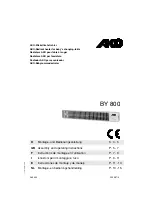
13
space shall be considered in making this determina-
tion. Each opening shall have a minimum free area of
1 in.
2
per 1,000 BTUH (2,225 mm
2
per kW) of the to
-
tal input rating of all gas utilization equipment in the
confined space, but not less than 100 in.
2
(645 cm
2
).
One opening shall commence within 12 in. (305 mm)
of the top, and one opening shall commence within 12
in. (305 mm) of the bottom of the enclosure. The min
-
imum dimension of air openings shall be not less than
3 in. (76 mm) in any direction.
All Air from Outdoors
The confined space shall communicate with the out-
doors in accordance with one of the methods below.
The minimum dimension of air openings shall not be
less than 3 in. (76 mm) in any direction. Where ducts
are used, they shall be of the same cross-sectional
area as the net free area of the openings to which they
connect.
1.
Two permanent openings
, one commencing
within 12 in. (305 mm) of the top, and one com
-
mencing within 12 in. (305 mm) of the bottom of
the enclosure, shall be provided. The openings
shall communicate directly, or by ducts, with the
outdoors or spaces (crawl or attic) that freely com
-
municate with the outdoors.
a. Where directly communicating with the out-
doors or where communicating to the outdoors
through vertical ducts, each opening shall
have a minimum free area of 1 in.
2
per 4,000
BTUH (550 mm
2
per kW) of total input rating of
all equipment in the enclosure.
b. Where communicating with the outdoors
through horizontal ducts, each opening shall
have a minimum free area of 1 in.
2
per 2,000
BTUH (1,100 mm
2
per kW) of total input rating
of all equipment in the enclosure.
2.
One permanent opening
, commencing within 12
in. (305 mm) of the top of the enclosure, shall be
permitted where the equipment has clearances of
at least 1 in. (25 mm) from the sides and back and
6 in. (152 mm) from the front of the appliance. The
opening shall directly communicate with the out-
doors or shall communicate through a vertical or
horizontal duct to the outdoors or spaces that free-
ly communicate with the outdoors, and shall have
a minimum free area of:
a. 1 in.
2
per 3,000 BTUH (740 mm
2
per kW) of
the total input rating of all equipment located in
the enclosure, and
b. Not less than the sum of the areas of all vent
connectors in the confined space.
A
WARNING:
Do not use one permanent open-
ing method if the equipment room is under neg-
ative pressure conditions or the equipment is
common vented with other gas-fired appliances.
1. Ventilation of the space occupied by the heater
shall be provided by an opening(s) for ventilation
air at the highest practical point communicating
with the outdoors. The total cross-sectional area
of such an opening(s) shall be at least 10% of the
area required in 2. and 3. (below), but in no case
shall the cross-sectional area be less than 10 in.
2
(65 cm
2
).
2. For heaters using a barometric damper in the
vent system there shall be a permanent air sup-
ply opening(s) having a cross section area of not
less than 1 in.
2
per 7,000 BTUH (320 mm
2
per kW)
up to and including 1 million BTUH, plus 1 in.
2
per
14,000 BTUH (160 mm
2
per kW) in excess of 1
million BTUH. This opening(s) shall be either locat
-
ed at or ducted to a point not more than 18 in. (450
mm) nor less than 6 in. (152 mm) above the floor
level. The duct can also “goose neck” through the
roof. The duct is preferred to be straight down and
terminated 18 in. (450 mm) from the floor, but not
near piping. This air supply opening requirement
shall be in addition to the air opening for ventilation
air required in 1. (above).
3. For heaters not using a barometric damper in the
vent system, and when air supply is provided by
natural air flow from outdoors for a power burner
and there is no draft regulator, drafthood or sim-
ilar flue gas dilution device installed in the same
space, in addition to the opening for ventilation air
required in 1., there shall be a permanent air sup-
ply opening(s) having a total cross-sectional area
A
CAUTION:
All combustion air must be
drawn from the air outside of the building; the
mechanical equipment room must communicate
directly with the outdoors.
Canadian Installations
A
WARNING:
Care must be taken to ensure
that the equipment room is not under negative
pressure conditions or that the equipment is not
common-vented with other gas-fired appliances.
Summary of Contents for Raypak Delta Limited 399B
Page 39: ...39 Wiring Diagram Models 399B 1259B...
Page 40: ...40 Wiring Diagram Models 1529B 2339B...
Page 51: ...51 DIAGNOSTIC DETAIL 12 J 7 J 6 J 5 J 3 0 2 0 16 S 1 F 2 F 3 F 4 F BLOWER DETAIL...
Page 53: ...53 13 J 8 J 10 J 11 J 4 J 2 J 3 J 6 C 14 J 9 J 1 J CONTROL BOX DETAILS...
Page 57: ...57 ILLUSTRATED PARTS LIST MODELS 989B 2339B 10 J 3 O 5 O...
Page 58: ...58 12 H 6 H 7 H 8 H 2 H 9 H 3 H 5 H 1 H 4 H 1 P HEAT EXCHANGER DETAILS BURNER ASSEMBLY DETAILS...
Page 59: ...59 CONTROL BOX DETAILS 9 J 8 J 23 S 13 J 10 J 3 O 10 J 3 O 5 O FRONT SWITCH DETAILS...
Page 66: ...66...
Page 67: ...67 Raypak Inc 2151 Eastman Avenue Oxnard CA 93030 805 278 5300 Litho in U S A NOTES...














































